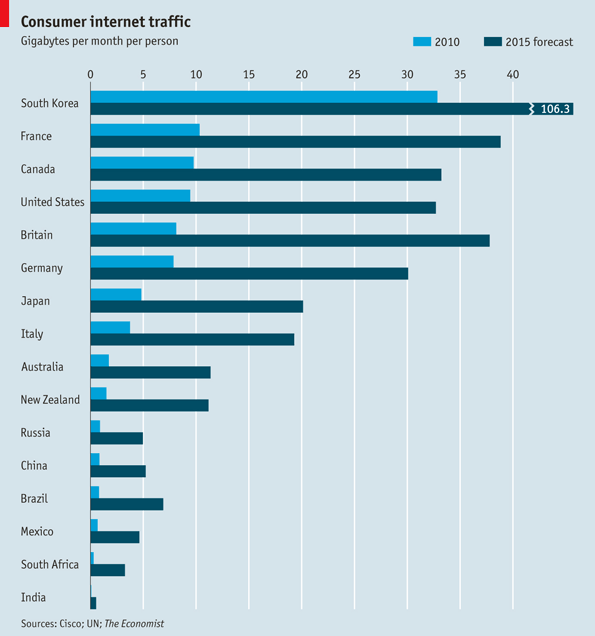Looking behind Ciscoâs broadband bikini
Thereâs a new study from Cisco on internet data usage floating around that probably needs some context attached to it before the usual suspects start blowing it out of proportion. As one of my high school history teachers used to say, statistics are like a bikini - they reveal a lot, but they hide whatâs most important. In other words, stats can be taken many different ways.
The chart below appears to indicate that Canadians are the third biggest users of data in the world. In 2010, Canadians used just under 10 gigabytes a month on average, with an expectation that that will climb to around 32 GB by 2015. In both cases, Canada would rank behind only South Korea and France in total usage.
The chart and numbers set off a few warning bells. In the first instance, Canadians apparently use more data than Americans, which seems unlikely given that Americans have access to more data-hungry internet applications, particularly video. Hulu is a big one, while Netflix is another. Netflix is, of course, available in Canada as well but like all such online video services here - Xbox Live and iTunes, just to name a few - its library pales in comparison to what can be had down south. Logic dictates that if thereâs better video available in the United States than in Canada, people there would use it more.
More interesting, though, is the fact that Australia and New Zealand also appear in Ciscoâs top ten usage list. As anyone who has lived in and used the internet in those countries can attest to, thatâs definitely impossible. Speeds are so slow and data caps are so low that the governments of both countries have had no choice but to get involved and build their own broadband networks. So how can Kiwis and Aussies be using enough data to rank in the top 10?
There are a couple of problems with Ciscoâs Visual Networking Index, particularly with how the above table is presented. If you drill down into the findings a little further and rank countries by how much data each household uses per month, a different picture emerges. Hereâs a ranking of what households in developed countries used in 2010, followed by the 2015 projection:
2010 Household Usage:
- South Korea 95 GB
- France 34.3 GB
- United States 31.8 GB
- Canada 30 GB
- Western Europe 27.1
- United Kingdom 26.4 GB
- Germany 23.6 GB
- Japan 18 GB
- Italy 16.7
- Australia 6.4 GB
- New Zealand 4.2 GB
2015 Household Projected Usage
- South Korea 298 GB
- United Kingdom 121 GB
- France 120 GB
- United States 110 GB
- Canada 99 GB
- Western Europe 90 GB
- Germany 90 GB
- Japan 68 GB
- Italy 80 GB
- Australia 44 GB
- New Zealand 33 GB
Thatâs a bit of a better picture because it shows what actual people use, rather than lumping in total internet usage, which can include businesses. As is obvious, Canada ranks a little worse while the United States takes its rightful place - by this measure, a typical American household uses more data than a Canadian one, which follows the logic above.
There are still questions, though, like why is Japan so low? Isnât Japan a super high-tech country where everyone is almost a cyborg? Well, yes indeed (except for the cyborg part). Japanâs super advanced cellphones are well documented and itâs the only country in the world where wireless carriers pull in more revenue from data than they do from voice.
The Wall Street Journal explained this a while back - internet usage on cellphones has become more popular in Japan than usage at home because of cramped living conditions and a train-commuting culture, among other factors. Bottom line: the average Japanese householdâs data usage is much higher than the above chart shows. Ciscoâs focus on the wired side of the equation is a concern raised by at least one other analysis firm.
Iâm also a little disconcerted by the lack of explanations for how and why traffic is expected to jump. A typical Canadian household will triple its traffic by 2015 while its U.K. counterpart will quadruple - why is that? Does Cisco know something the rest of us donât? Will Hulu launch in the U.K. but not Canada?
Whatâs most concerning is the decision to lump a bunch of countries into the “Western Europe” category. Given that the Netherlands and Scandinavian countries are leaders in many other broadband measures, this seems to be a strange move - and one that likely waters down strong numbers from those jurisdictions with ones from weaker-showing nations, like Spain and Portugal. The chart above would likely look very different if Finland, Sweden et al were included.
If Western Europe is not included in those household tables above - which is fair because it wasnât included in the overall usage chart - whatâs the end result? Canadian households rank fourth out of 10 developed countries in wired data usage today, behind the United States (naturally), and will slip to fifth in the next five years. That means Canadians are pretty much middle of the pack of a select group of countries.
Thatâs hardly the same as the “Canadians are the worldâs third-biggest data users” headline some are likely to suggest.


The whole use of an ‘averageâ is screwed up anyways… barely tells you anything without at least knowing the curve of how many people use higher amounts of data.